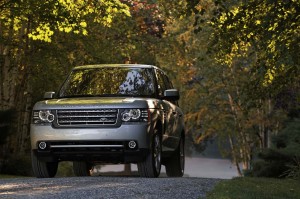
When autumn leaves come tumbling down...it's time for the debut of the 2010 Land Rover Range Rover Autobiography, the most exclusive edition ever from the British marque.
It’s been said that the automobiles we buy are an extension of our personality. For some, basic transportation is all that matters. For others, nothing but the best will do. Some just want an appliance on wheels, others a vehicle with a distinct personality. There are those who are fine with an anonymous automobile that can blend in anywhere.
Then there are those who want to turn heads everywhere they drive, with a car that’s not just stylish but which offers the ultimate in performance and creature comfort. That’s the sort of buyer Land Rover has in mind with its all-new, 2010 Range Rover Autobiography.
The aptly-named, top-line version of the updated 2010 luxury SUV is targeted at the most exclusive and demanding customers, folks who typically trade in every year or so, just so they aren’t missing out on the latest features, and who can afford just about anything they want, even after the past year’s economic meltdown.
And what do you get for your $110,000 – about $15,000 more than an otherwise well-equipped but conventional Range Rover?
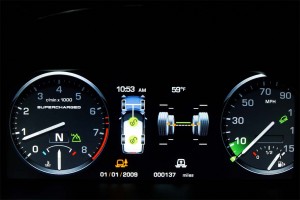
The 2010 Land Rover replaces analog gauges with a flexible 12-inch TFT display. Off-road the speedo shifts right, new data popping up in its place.
You start out, as that implies, with the 2010 update of the British marque’s top-line ute. At first glance, you might not notice much of a difference. The basics of the Range Rover were set in place even before Ford acquired Land Rover from BMW. But over the years, things have slowly but steadily evolved. For the new model year, the goal, according to chief designer David Saddington, was to make the car look “more formal and more elegant.”
That means some modest exterior touches, including new headlamps, a revised grille and modest tweaks to the bumper. The striking front “signature” lamps now use LED bulbs, as do the taillamps. The supercharged versions of the Range Rover – which include the Autobiography edition, carry over the three-bar grille to the now functional side intakes.
The cabin has been refined on all new Range Rover editions, though most of this can best be seen by looking for subtle details like the updated, backlit switches. But one of the most striking changes for 2010 is located where you’d normally find analog gauges. For 2010, Land Rover has adopted a positively massive 12-inch TFT video screen.
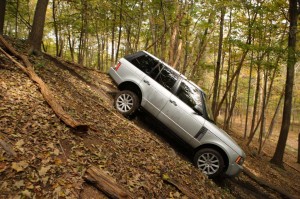
The Hill Descent and Terrain Response systems maintain an uncanny grip even in the worst of on or off-road conditions.
During normal driving conditions, you might not even notice that such instruments as the tach and speedometer are, in fact, digital imagery. But switch to off-road mode and the gauges shift position, providing room for a variety of readouts showing, for example, whether you’re in low gear, and which mode Terrain Response Control has been set too. Indeed, the video display is constantly changing, depending on road and driving conditions, but the layout is intuitive and easy to follow.
With the Autobiography, Land Rover has tried to address the demands of its most affluent customers, those who never think there’s enough wood or leather. Indeed, about the only place you won’t find cowhide is on that TFT display and on the various knobs and switches. And the leather is semi-analyne, which has a distinctly soft and pleasant feel.
The 2010 Land Rover Range Rover Autobiography (say that in one breath) also comes with a 4-zone climate control, and climate glass – which reduces solar load on a summer day. Active Cruise Control and a reclining rear seat are standard. In fact, there are only a few options available, notably a 1200-watt, 19-speaker Harmon-Kardon audio system.
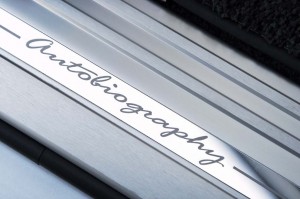
At $110,000, the 2010 Land Rover Range Rover Autobiography adds an array of features, such as Active Cruise, as well as even more wood and leather than you'd normally anticipate.
One surprise was the lack of paddle shifters, which Land Rover does make available on the Range Rover Sport. Stay tuned, sources tell us, and we expect that feature to appear by 2011 or so.
For the new model-year, the Range Rover line gets two new engines, starting with a 5.0-liter naturally-aspirated V8 delivering 375 horsepower, a 23% increase, and 375 pound-feet of torque, which is up 16%. That’ll get you from 0 to 60 in about 7.2 seconds. Fuel economy numbers aren’t yet available, but despite the increased performance, Land Rover saw a solid 7% increase using European government standards. For the U.S., however, it expects the mileage to roughly match last year’s base car, around 12 City/18 Highway.
The top-line powerplant – which is the only one available in the 2010 Range Rover Autobiography – is a supercharged version of the 5.0-liter 8-banger, here making 510 hp, a 29% improvement, and 461 pound feet. Launch times come in around 6.0 seconds, and mileage should average a couple mpg less than the naturally-aspirated engine.
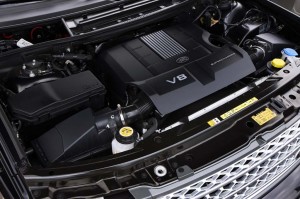
The supercharged 5-liter V-8 in the 2010 Range Rover Autobiography makes 510 hp and 461 lb-ft of torque, while the normally-aspirated V-8 makes 375 hp and 375 lb-ft.
Both engines are linked to a 6-speed ZF automatic which, in turn, can direct torque to any or all four wheels. The All-Wheel-Drive system on the Range Rover is one of the most sophisticated you’ll find and, surprisingly, company data suggest as much as a third of owners will drive off-road at some point, though to many, that is likely to translate into a gravel or dirt road to the lakefront cottage.
Blower versions, including Autobiography, can nip 140 mph, despite the Range Rover’s mass and aerodynamic drag. To help scrub off speed, it’s equipped with 6-piston Brembos. The naturally-aspired model gets 4-piston brakes.
To get a sense of driving the 2010 Land Rover Range Rover Autobiography, we headed to New England, just as the leaves were reaching peak color. On paved roads, the big SUV will surprise you. Tip in on the throttle and you’ll feel yourself instantly sinking deep into the plush but supportive seats, No, you can’t completely forget its mass – curb weight running just shy of three tons – but the vehicle proved far more nimble and compliant than such a number might suggest.
Land Rover engineers have done a surprisingly good job of balancing steering so you don’t feel the ute’s heft yet still maintain a clear connection to the road. It proved relatively easy to shoot through sharp corners without scrubbing off much speed, and there’s surprisingly little body roll. The latest electronic damping system is designed to not only read the road but anticipate what’s ahead, so in a corner, it will stiffen up the outer shocks to keep the Range Rover almost uncannily level.
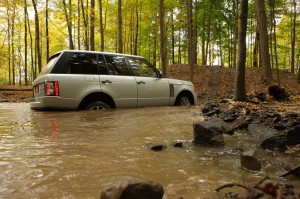
A surprising number of Range Rover owners claim they go off-road, where they can ford up to 24 inches of water.
What’s particularly amazing is the dexterity the Range Rover showed off-road. After three days of heavy rain, the course was largely coated with a molten ooze, so there were times you simply slipped into a deep rut and let it carry you forward, but elsewhere, the big SUV maintained tremendous control.
Much of that has to do with the Terrain Control System. It offers a half-dozen settings, such as Mud-and-Ruts, or Sand, each instantly adjusting a host of vehicle settings – such as gear range, steering, brakes, throttle response and suspension height – to deliver the best possible traction under the appropriate conditions.
It’s still hard to get used to the Hill Descent Control, however, as we were reminded when our off-road guide led us to the edge of a two-story tall cliff and told us to jump off. Well, not quite, but as we crested the peak and aimed seemingly straight down, he reminded us to lift off the brakes, “and let it do the work for you.” Which the Range Rover did with aplomb, the Hill Descent system carefully maintaining a speed of just under 3 mph all the way down.
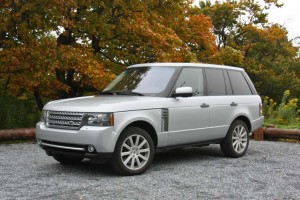
Despite weighing nearly 3 tons, the supercharged versions of the 2010 Land Rover Range Rover can launch from 0 to 60 in 6.0 seconds.
Would we be willing to put a $110,000 ute through this sort of terrain? Not if it were ours, but apparently, plenty of owners do. And even if you’re just facing the occasional white-out blizzard, it’s nice to know the capabilities are there to handle just about anything nature can throw at you.
The 2010 Land Rover Range Rover Autobiography isn’t for everybody. But for those who have the money and, yes, we’ll say it, the ego, this luxury SUV is likely to strike a resonant chord. The “base” Range Rover is already a luxurious offering, and the Autobiography package pumps it up a couple notches, making it a worthy addition for those who already park a top-line luxury sedan or sports car in the garage. And we’re betting the keys for the Range Rover Autobiography are the ones they’ll find themselves reaching for most often.

Given LR sales aren’t all of its models “exclusive.”